
Happy Birthday to Paul Weller, who celebrates his 52nd birthday today. To mark the event we take a look through his extraordinary career, which is going as strong as ever over thirty years since he first burst onto the music scene.
When Paul Weller walked away from The Jam at the end of 1982 it was another impulsive move from a fiercely ambitious, driven man who in just five years had earned a reputation as one of the most engaging and creative songwriters of his time.
In doing so, he had taken his group from the brink of failure after the release of their second album to the biggest in Britain. At the age of just 24, he was the frontman of a band enjoying success in the UK not seen since The Beatles, a hero to millions of fans. But now he had left at the height of their powers to pursue completely new avenues.
His story was far from over.
Born 1958 in Surrey, Paul was named John William Weller by his parents John, a taxi driver and Ann, a part-time cleaner. By the age of fourteen, inspired by the legendary British bands of his youth, Weller had already formed The Jam, initially taking up the role as bass player alongside childhood friends Steve Brookes and Dave Waller.
After playing gigs organised by his father in various working men’s clubs, Weller and co. were soon joined on drums by Rick Buckler before Brookes, unhappy with the direction his band was going in, was replaced by Bruce Foxton. With Brookes departed, the classic Jam line-up had taken shape as Weller and Foxton exchanged guitar duties and, after making steady progress on the London club scene, they signed to Polydor Records.
By 1977, they were ready to record their first album.
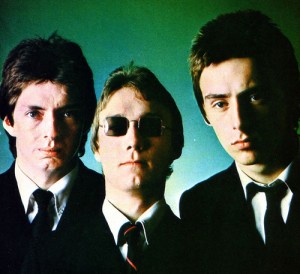
Weller with his Jam bandmates Foxton (far left) & Buckler (centre)
The trio emerged with debut record ‘In The City‘ in the May of ’77, led by the title-track and lead single which instantly highlighted Weller’s knack for social commentary and became an instant anthem for the youth of the day.
Released at the height of the punk scene, the album pushed The Jam to the forefront of the movement, yet it was clear to everyone that this was a band by no means falling in line with the self-imposed ideologies of punk. Indeed, their successes would transcend far beyond punk’s implosion not long after.
Weller made no secret of his love for punk, both in its power and attitude, but his rebellious streak and contempt for authority, which had been apparent right from his school days, made it impossible for him to ever fall in line with the genre’s traditional ethos.
The Jam happily championed the sixities British acts which were sneered at by so many of punk’s leading lights, while their habit of playing in matching suits also helped to distinguish themselves from the DIY style of the era, and was an obvious two-fingered gesture to any rules being laid down by their rivals. It put The Jam as close to The Beatles as they were to the Sex Pistols.
Following their debut release, it was far from a smooth ride for Weller and The Jam. Although the non-LP single ‘All Around The World‘ of July 1977 had further confirmed the band’s rising status in the UK, under pressure to lay down a new album as quickly as possible the second effort ‘This Is The Modern World‘ was widely seen as a critical and commercial failure.
With Weller’s confidence stung by this disappointment, attention subsequently turned to bassist Bruce Foxton, who had contributed songwriting to the band’s earlier efforts, to be the driving force behind their third studio LP. The excellent Foxton-penned single ‘News Of The World‘ handed The Jam a top 30 hit in March 1978, and they re-entered the studio intent on recording an album driven by their bass player.
It wasn’t to be; the sessions broke down with producer Chris Parry dismissing the new tracks as sub-standard. After climbing the mountain with ease, they had just as quickly come close to falling off the edge. At a critical time Weller, who had lost all interest in writing, returned home looking for fresh inspiration. Reaching back to his earliest influences, especially The Kinks, Weller’s first mini-crisis was averted, and the band were soon back in the studio led by a re-invigorated talisman armed with a host of new songs.
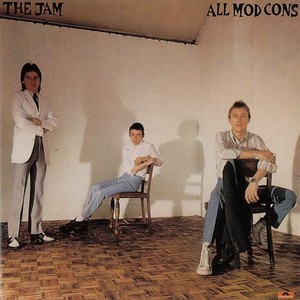
An undoubted success, the result of those sessions, ‘All Mod Cons‘, is Weller’s first true classic. Released towards the end of 1978, The Jam’s third studio album instantly blew away any doubt which had been hanging over the band since the release of ‘This Is The Modern World‘. The record presents Weller truly finding his feet as a songwriter, skilfully combining the power and passion of punk with the classic sounds of his early heroes, as well as offering the first signs of a desire to explore other genres of music in his writing.
‘All Mod Cons‘ is packed with instant classics from start to finish; tracks such as ‘A-Bomb In Wardour Street‘ and ‘To Be Someone (Didn’t We Have a Nice Time?)‘ continued the sharp line tradition of The Jam’s debut, yet with tracks such as ‘In The Crowd‘ and ‘English Rose‘, Weller also displayed a love for soul and classic R n B which would sonically become a big part of The Jam towards the end of their career, and which would dominate Weller’s songwriting for a large part of the next decade.
The cover of ‘David Watts‘ of course offers a nod to one of Weller’s biggest inspirations, Ray Davies, whose band was so crucial in galvanising him following the collapse of the 1978 initial sessions. Closing the album is one of Weller’s finest tracks, ‘Down In The Tube Station At Midnight‘, whose haunting vibe and perfect production tells the story of a vicious mugging deep in the London underground. It handed The Jam another top 10 hit when it was released in October 1978.
Following the achievements of ‘All Mod Cons‘, two more non-album singles soon had The Jam back in the UK Top 20 and the follow-up album ‘Setting Sons‘ arrived in November 1979.
The record further cemented The Jam’s position as one of the most popular bands of the day, and continued the positive critical response first truly achieved with ‘All Mod Cons‘. Originally conceived by Weller as a concept album, it is arguably The Jam’s most ambitious even though the concept was never fully realised. The wider scope and new directions being sought, including an all-strings arrangement of the previous Foxton-written b-side ‘Smithers-Jones‘, were further signs of the group’s move into a more sophisticated sound, of Weller’s deep desire for The Jam to rapidly evolve.
Slightly patchier in quality than their previous effort, the album nevertheless continued the momentum from ‘All Mod Cons’, and also spawned a first Top 5 hit when ‘The Eton Rifles‘, motivated by the late-seventies Right To Work marches, peaked at #3 in November 1979.
‘The Eton Rifles‘ was the first of four successive truly classic singles from the band, and by the time they were ready to release ‘Sound Affects‘ in 1980, a first UK no.1 single had been achieved with ‘Going Underground‘; Paul Weller was well on his way to being considered one of the most talented and important songwriters of his generation.
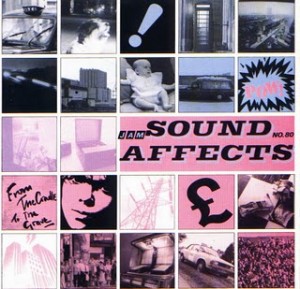 Fittingly then, ‘Sound Affects‘ confirms Weller as one of the best social commentators of his time – whether as observer or participant. The themes running through the record, epitomised in the brilliant single ‘That’s Entertainment‘, open a window onto British life at the time, helping to make The Jam an important part of the lives of a whole generation.
Fittingly then, ‘Sound Affects‘ confirms Weller as one of the best social commentators of his time – whether as observer or participant. The themes running through the record, epitomised in the brilliant single ‘That’s Entertainment‘, open a window onto British life at the time, helping to make The Jam an important part of the lives of a whole generation.
‘Sound Affects‘ was another genuine classic, and again displayed Weller’s ever increasing move away from traditional British rock which would become still more apparent on their next, and last, album ‘The Gift‘.
Musically diverse, there are still moments of traditional Jam on tracks such as ‘But I’m Different Now‘ and ‘Set The House Ablaze‘, but with influences from an ever growing list of acts and genres, from emerging new wave bands such as Joy Division to Michael Jackson’s seminal ‘Off The Wall‘, the record also continues to reveal a progression in writing, especially on ‘Monday’ and ‘Boy About Town’.
The make-up of ‘The Gift‘, funk, soul and jazz throughout, is a clear indication of where Weller would be going in the future, while the mixed reaction from fans and critics alike showed that he would indeed need to move away from the constraints of The Jam to fully realise his future plans.
Despite the lukewarm response, the record contains moments of brilliance, at a time when The Jam were at their commercial peak. Weller’s knack for classic singles was still in evidence; the double A-side ‘Precious/Town Called Malice‘ becoming their third UK no.1 in January 1982. It was soon after the album’s release when Weller broke the news to his stunned bandmates of his intention to leave the group following the completion of their touring that year. After a final show in Brighton, and with The Jam at no.1 with ‘Beat Surrender‘, Paul stayed true to his word and walked away from the biggest thing in British music at the time.
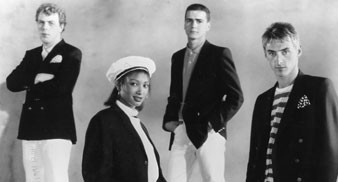
The Style Council: (l-r) Mick Talbot, Dee C. Lee, Steve White, Paul Weller
While Bruce Foxton and Rick Buckler were left wondering what to do with the rest of their lives, Weller’s vision for his own future was already being realised. Before The Jam had even officially disbanded he was on the phone to keyboardist Mick Talbot and, in search of a soulful female voice for his new project, singer Dee C. Lee. The new direction was immediately apparent when The Style Council released their first single ‘Speak Like a Child‘ in 1983. Weller was out to challenge the misconceptions which had surrounded him during his time in The Jam. The 1984 second album ‘Cafe Bleu‘ brought further re-invention, featuring instrumentals and Weller taking lead vocals on just a handful of tracks.
By the end of 1984, Weller was immersing himself in the political and social issues of eighties Britain, the 1985 album ‘Our Favourite Shop‘ packed with personal views on the contrasting left/right ideals of the period.
In the grandest tradition of The Jam, it gives a real insight into the struggles with unemployment suffered by so many in the UK at the time; despite now being one of the most successful musicians in history, Weller was still able to associate himself with the people he had grown up with, and the LP fittingly became The Style Council’s only UK No.1 in May ’85.

Weller with politicians Livingstone & Kinnock
However, Weller’s association with the doomed Red Wedge initiative – a tour initiated by a selection of acts of in support of the Labour Party – was a step too far which pushed the band deeply into a troubled world of politics at a time of high tension, not only in the UK but in many part of the world.
As a disenfranchised left fought with the electorate’s right, the group courted criticism as the focus centred on politics, and many people began to lose interest in what The Style Council might still have had to offer.
Much of what Paul Weller had envisioned for the group had been achieved, and some new ideas now being pursued were becoming ever more ill-judged (the less said about Jerusalem the better). In total contrast to The Jam, The Style Council were beginning to out stay their welcome. Reviews, which had always been mixed from a gang of critics uneasy with Paul’s change of image, became more vitriolic, and when sales also started to decline The Style Council’s days were inevitably coming to an end.
Towards the end, Weller’s new obsession was the late 80s house scene which was sweeping through Britain and becoming a significant youth movement. Yet his desire to explore this new genre only brought more cynicism. As always, he began to let this new love come through in his songwriting, but this time it provoked an angry response from fans. When their label Polydor also rejected the new dance inspired material in 1989, the game was finally up for The Style Council. Unlike The Jam, it had been a hugely disappointing conclusion, somewhat out of Weller’s control.
An end which would take him years to recover from.
The nature of the demise of The Style Council hit Weller hard, and ushered in a low point in his career. The final years of his second band, particularly the failed move into dance music, had made Weller a deeply unfashionable character, his heyday with The Jam and early Style Council a distant memory.
This period did though provide time to start a family. Weller had married bandmate Dee C. Lee in 1988, and his first real break from music since he first hit the London scene with The Jam over a decade earlier meant that while his professional life seemed to be at a stand-still, his personal life was stronger than ever.
Weller’s huge passion for music would never fade however, and it wasn’t long before he was back on stage finding his way once more as a performer. The first real signs re-emergence came quickly with the 1992 debut solo record, which presents a musician growing in confidence once again, and a sound which is an obvious sign of a musician falling back in love with the influences of his youth.
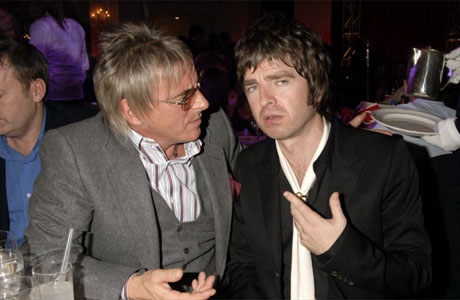
Weller with Noel Gallagher
Paul returned a year later ‘Wild Wood’, with his writing more prolific than ever, oozing with self-assurance and belief, and containing some his best work. As in 1978, Weller had again emphatically proved his critics wrong, and seemingly out of nowhere had produced his best album in a decade. It was perfect timing as Oasis lead a clutch of new Britpop bands hailing his influence on a whole generation of musicians. Weller was back as one of the biggest stars in Britain, still brimming with new ideas.
 Hot on the heels of the success of ‘Wild Wood’, with Britpop now gripping Britain, Weller was back with his third solo effort ‘Stanley Road‘. Easily rising to the marker laid down in 1995 by some classic releases such as Oasis‘ ‘(What’s The Story) Morning Glory?’, Pulp’s ‘Different Class‘ and Manic Street Preachers’ ‘Everything Must Go’, ‘Stanley Road‘ retains the assured, relaxed mood of its predecessor, and is a brilliantly consistent collection of songs as Weller is heard reflecting on childhood and his upbringing in Woking.
Hot on the heels of the success of ‘Wild Wood’, with Britpop now gripping Britain, Weller was back with his third solo effort ‘Stanley Road‘. Easily rising to the marker laid down in 1995 by some classic releases such as Oasis‘ ‘(What’s The Story) Morning Glory?’, Pulp’s ‘Different Class‘ and Manic Street Preachers’ ‘Everything Must Go’, ‘Stanley Road‘ retains the assured, relaxed mood of its predecessor, and is a brilliantly consistent collection of songs as Weller is heard reflecting on childhood and his upbringing in Woking.
As ever, memorable singles were ready to go; ‘The Changingman‘ and ‘You Do Something To Me‘ provided consecutive Top 10 hits in ‘95, while ‘Broken Stones‘ captures everything that was great about his songwriting at the time; calm, reflective, underpinned with real conviction. It is easily one of the best songs he has ever written. The album itself was his first no.1 since 1985 and his career, now in its third decade, was as bright as it had ever been.
Seven more solo albums have followed ‘Stanley Road’, and Weller’s most recent album, ‘Wake up The Nation’, was as well as received as anything since 1995. With the respect of both his peers and a whole new generation of musicians and fans now unquestioned, Paul Weller is regarded as one of the most important songwriters of the last century, and comfortably sits alongside those heroes whose path he dreamed of following as a child.
Such a long and varied career makes it easy to label Paul Weller with many titles and descriptions but the most appropriate, and the one which sums him up best, is fittingly the one he is best known by:
The Modfather.
(Dave Smith)





Happy Birthday Mr. Weller! You’re THE legend!
Great article to read. Well done, Dave!
Really enjoyable article to read, but real pity it died a death after Stanley Road and therefore does a real disservice to the last 15 years of Paul’s career
King Paul…coz Its all Paul….
Mr.Weller is two years my junior and it’s my opinion that he’s done more for both England and Music than the last 3 or 4000 tossers attempting to compose and play- Cheers to a man and his journey.